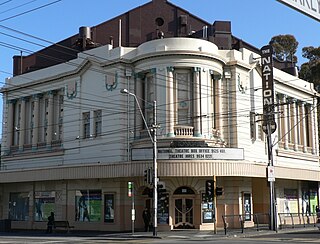Related Research Articles

The Royal Ballet is a British internationally renowned classical ballet company, based at the Royal Opera House in Covent Garden, London, England. The largest of the five major ballet companies in Great Britain, the Royal Ballet was founded in 1931 by Dame Ninette de Valois. It became the resident ballet company of the Royal Opera House in 1946, and has purpose-built facilities within these premises. It was granted a royal charter in 1956, becoming recognised as Britain's flagship ballet company.
The Australian Ballet (TAB) is the largest classical ballet company in Australia. It was founded by J. C. Williamson Theatres Ltd and the Australian Elizabethan Theatre Trust in 1962, with the English-born dancer, teacher, repetiteur and director Dame Peggy van Praagh as founding artistic director. Today, it is recognised as one of the world's major international ballet companies and performs upwards of 150 performances a year.
Ross Stretton was an Australian ballet dancer and artistic director. As a dancer, he performed with the Australian Ballet, the Joffrey Ballet and the American Ballet Theatre. He was later Artistic Director of the Australian Ballet (1997–2001) and the Royal Ballet (2001–2002).

Tamara Rojo CBE is a Spanish ballet dancer. She was the English National Ballet's artistic director and a lead principal dancer with the company between 2012 and 2022. She was previously a principal dancer with The Royal Ballet. She became the artistic director of San Francisco Ballet in late 2022.

Natalia Romanovna Makarova is a Russian prima ballerina and choreographer. The History of Dance, published in 1981, notes that "her performances set standards of artistry and aristocracy of dance which mark her as the finest ballerina of her generation in the West."
The Australian Ballet School is the premier ballet training facility in Australia, located in Melbourne.
Dame Catherine Margaret Mary Scott, was a South African-born pioneering ballet dancer who found fame as a teacher, choreographer, and school administrator in Australia. As the first director of the Australian Ballet School, she is recognised as one of the founders of the strong ballet tradition of her adopted country.

Dame Margaret van Praagh was a British ballet dancer, choreographer, teacher, repetiteur, producer, advocate and director, who spent much of her later career in Australia.

The National Theatre is a 783-seat Australian theatre and theatrical arts school located in the Melbourne bayside suburb of St Kilda, on the corner of Barkly and Carlisle Streets. The building was constructed in 1921 as The Victory Theatre, rebuilt as 2550 seat cinema in 1928, finally converted to a live venue in 1972/4 with 783 seats. The stalls seating was converted to studios and rehearsal rooms for the schools.

Leanne Faye Benjamin is a retired Australian ballet dancer who was a principal dancer with the Royal Ballet in London. She was appointed artistic director at the Queensland Ballet in 2024. She stepped down from the position on 2 August 2024.
Maina Gielgud is a British former ballet dancer and a veteran ballet administrator. She was artistic director of The Australian Ballet from 1983 to 1996. She had a twenty-year career as a dancer in Europe and the United Kingdom. Gielgud directed the Royal Danish Ballet between 1997 and 1999. Until 2005, she held the artistic associate position at the Houston Ballet. She is a daughter of Lewis Gielgud and actress Zita Gordon and niece of actor Sir John Gielgud.
Jodie-Anne White-Bivona was an Australian dancer, choreographer and artistic director of the Ballet Theatre of Queensland.

Edouard Borovansky was a Czech-born Australian ballet dancer, choreographer and director. After touring with Anna Pavlova's company, he and his wife, Xenia, settled in Australia where they established the Borovansky Ballet company. This company provided the foundation for modern ballet in Australia and was subsequently used as the basis for the first national Australian ballet company, The Australian Ballet which was established in 1962.

Laurel Martyn was an Australian ballerina.

Roma Jean Egan was a child actress on Australian television, and an Australian ballet dancer and teacher. She was notably a senior soloist for The Australian Ballet, and variously performed for the Queensland Ballet, Basel Ballet, Ballet Victoria and Royal New Zealand Ballet.
Lana Jones is an Australian retired ballet dancer. She was a principal dancer with The Australian Ballet, and danced with the company for 16 years.
Cynthia Harvey is an American former ballet dancer, ballet mistress and educator. She joined the American Ballet Theatre (ABT) in 1974 and was promoted to principal dancer in 1982. In 1986, she joined The Royal Ballet, becoming the company's first American principal dancer. She returned to ABT two years later, and retired in 1996. She then started teaching and staging ballets across the world. Between 2016 and 2022, she was the artistic director of the Jacqueline Kennedy Onassis School, the affiliated school of ABT.

Michelle Anne Potter is an Australian dance writer, critic, archivist, and curator of historical materials. Her research and writing have focused on but have not been restricted to Australian dance history. She was honoured for her achievements with the award of Member of the Order of Australia (AM) in the 2023 Australia Day Honours list.

Stella Abrera is a Filipina-American ballet dancer. She danced as a principal dancer with American Ballet Theatre until her retirement in 2020, and is the company's first Filipina principal ballerina. She then became the artistic director of the dance cultural park Kaatsbaan, and in September 2022 took up the role of artistic director of the ABT JKO School. following Cynthia Harvey's departure in May.

Marjorie Lucas (1905–1995) was a ballet dancer and dance teacher from Queensland, Australia. She was instrumental in the development of ballet in Queensland.
References
- ↑ Karin, Janet (1 August 2023). The Art and Science of Ballet Dancing and Teaching: Integrating Mind, Brain and Body. Taylor & Francis. ISBN 978-1-000-91569-3.